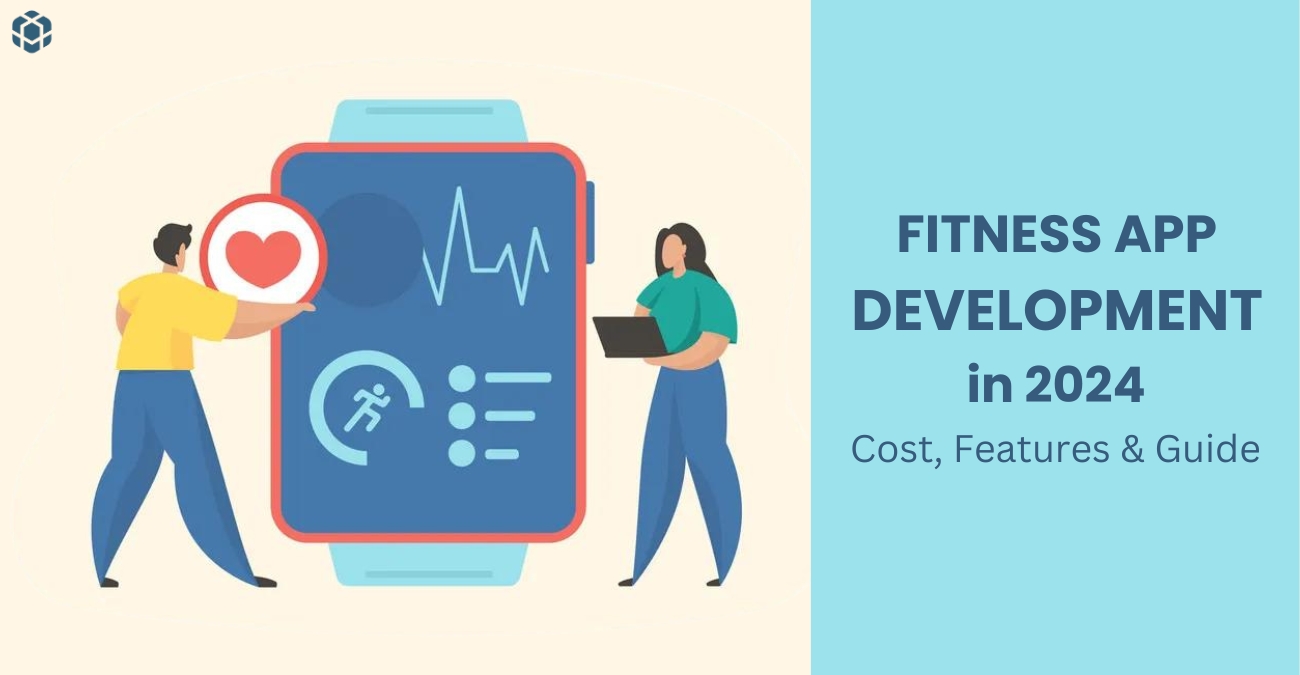
Fitness has always been the talk of the generation, whether you are a fitness freak or have been a constant part of the thriving journey. Fitness applications have become a necessary component of our everyday lives as a result of the growth of digital health and wellness. The worldwide fitness app market is predicted to grow exponentially by only a few years, making today the ideal moment to enter the fitness app development industry.
These days, fitness applications are extremely popular. As people become more conscious of their health and fitness, fitness applications are now a standard feature on practically all smartphones. The greatest choice for making money is to use these apps. The majority of smartphone users choose to utilize these applications, which allow them to access dietary plans, customize workouts, and get expert fitness advice, in order to adhere to the fitness schedule.\
Although “fitness” is merely a phrase, its meaning has expanded due to the expanding internet community. Use of mobile apps is easy and beneficial for all needs. To provide us with greater convenience, mobile app development services integrate or tie our wants to virtual environments. With their multitude of capabilities, the applications are revitalizing the entire health and fitness system.
This article explores everything from market research to the specifics of fitness app development and monetization. Now, let’s set out on this adventure and discover the dynamic world of fitness applications in the present day.
Overview of the Fitness App Market
Technology breakthroughs and a growing emphasis on global health are driving a dynamic blend of breakthroughs and expansion in the fitness app market in 2024. Let’s overlook some of the factors:
Market expansion
The thriving fitness app market is an indicator to its promise and success. Otherwise, why would we be talking about developing an exercise app? The potential is rather great. To support your decision to enter this market, let’s look at some positive statistics and projections.
The market for fitness apps has expanded rapidly. These apps have become popular among exercise lovers as a practical and customized replacement for conventional gyms and fitness centers. With a predicted growth rate of 30.91%, the worldwide fitness app market is expected to reach USD 14102.49 million by 2027 from its 2021 valuation of USD 2801.48 million. This remarkable increase is credited to the growing focus on leading healthy lives, the ease of use provided by these applications, and their cutting-edge features, which meet a variety of fitness requirements.
This tendency has been further pushed in the post-pandemic era as more people realize the benefits of app-based fitness versus traditional gyms. This change is further highlighted by the growing online presence of gyms and fitness centers as well as vibrant social networks. To put things in perspective, 400 million fitness applications were downloaded in 2023 alone.
Types of Fitness Apps in 2024
It’s important to know the many kinds of fitness applications that are out there before diving into how to make your own. This will assist you in defining your unique value proposition, identifying your target market, and figuring out the essential features of your app.
Personal fitness apps: Offer customized training regimens, activity monitoring, and performance evaluations that include goal-setting and progress monitoring.
Fitness Apps for Wellness and Mental Health: Incorporate tools that promote mental health, such as sleep tracking, stress management techniques, and meditation guides.
Apps for Diet and Nutrition: Utilize meal planners, food trackers, and comprehensive nutritional data to concentrate on managing your diet.
On-call fitness applications: Provide expert trainer-led exercises that are available at any time, catering to a variety of schedules and fitness levels.
Apps for Fitness Shopping: Provide a website where customers may shop for clothing, accessories, and other related things.
Apps for Tracking Fitness: Establish a connection with wearables or phone sensors to track and log physical activity.
Fitness apps powered by AI: Make advantage of artificial intelligence to offer individualized diet and exercise programs based on user information and past workout performance.
Switch to Earning Apps: Give consumers tokens or points for their physical activity; they can be exchanged for rewards or used for in-app purchases.
Fitness Apps for Virtual Reality: Make interesting and exciting exercise experiences in a virtual setting by utilizing virtual reality.
Social Fitness Apps: Provide a social network or community where fitness enthusiasts may interact, challenge one another, and their success.
Fitness App Development Costs
Developing fitness apps surely seems like a bigger investment, but it does not come with any handy costing approaches. The more you need to make it useful for additional fitness features, the more investment you may need to put in.
The cost of creating a basic product for a fitness or health application may range from $20,000 to $30,000. App development expenses for a fully functional fitness product might vary from $60,000 to $160,000, based on whether the following features must be implemented:
- Feature streaming video and voice integration, among others.
- AI/ML technology for identifying features like a user’s movements during a workout.
- Several hardware connectivity options including BLE.
The following list outlines the essential functions of fitness apps, the approximate number of hours needed to develop them, and the related expenses based on average hourly rates currently offered:
- Push Alerts: for 20–40 hours, Between $800 and $1,600
- Guides on video or audio:, 130–170 hours, Between $5,200 and $6,800
- Tracking Your Basic Fitness: 40–80 hours, From $1,600 to $3,200
- User profiles: 50–70 hours, Between $2,000 and $2,800
- Integration with Society: 60-80 hours, Between $2,400 and $3,200
- Time zone: 80-100 hours, $3,200–$4,000
- Integrated Wearables: 120-160 hours, Between $4,800 and $6,400
- Exercise Schedules: 100–150 hours, Between $4,000 and $6,000
- Tools for Diet and Nutrition: Between 80 and 120 hours, Between $3,200 and $4,800
- In-app purchases: 60–80 hours, Between $2,400 and $3,200
- Support for several languages: 30–50 hours, Between $1,200 and $2,000
- Cloud Syncing and Data Retention: 60–90 hours, Between $2,400 and $3,600
- Total Estimate: 830–1,110 hours, $33,200–$44,400
Also Read, How Long Does it Take to Build Another App
Most-Used Fitness Apps Features
Apps for Nutrition and Diet: Help with meal preparation, calorie tracking, and nutritional guidance.
Online trainers: augmented reality and virtual reality devices for immersive training at home.
Mental health elements: Integrating mindfulness and meditation with physical exercise.
Tech gadgets: Monitoring data in real time with fitness bands and smartwatches.
Automated workouts: Customized exercise regimens built on user information.
National insights: Although western population is in the lead, the Asia-Pacific area—particularly the middle east—is quickly catching up as a result of urban populations’ preference for digital fitness solutions.
Players in the market: While well-known apps like Fitbit and MyFitnessPal are still in use, niche firms are starting to appear and provide specialized services.
User characteristics: Even though current generations are the main users, usage within the 45–54 age group has grown substantially, suggesting greater recognition across generations.
Exercise Manuals: Provide outlined exercise regimens that include animated or video tutorials.
Possibilities and difficulties: There are issues with market saturation and data privacy. Nonetheless, there is a market for distinctive apps that put community development and user data safety first.
The market for fitness apps is enormous and diverse. Whether your target market is die-hard fitness enthusiasts, people trying to lose weight, or those looking for mental calm, there’s a market out there just waiting to be discovered. The first step to developing a great fitness app is selecting the appropriate category and learning about its unique characteristics.
Easy Steps to Build Your Own Fitness App
It takes a methodical approach to start a fitness app development journey. Every stage, from conception to release, is critical to guaranteeing the app’s success and user involvement. This is a thorough guide that will walk you through the essential steps to developing your fitness app idea:
1. Market analysis
Prior to beginning development, it is critical to comprehend the industry, spot loopholes, and ascertain customer wants.
Important measures:
- Analyze competitors by examining current apps to determine their advantages, disadvantages, and special features.
- Identify your target audience by describing your main users’ inclinations and fitness objectives.
- To make sure your app stays current, keep up with the most recent developments in technology and fitness trends.
2. User Experience and Design
Your app’s usability and intuitiveness can make or ruin it. Make user experience (UX) a top priority to guarantee simple access and user engagement.
Important measures:
- Draw a schematic of the main components, organization, and functionality of your application.
- Creating a clickable prototype of your application will allow you to test and improve the user experience.
- When it comes to user interface (UI) design, pay attention to aesthetics and make sure the layout complements your brand.
3. The Development Process
The goal of this phase is to turn the app’s layout into a working final product. Joining forces with a reliable partner can have a big impact on how well your app does. Therefore, it’s crucial to choose the right platform, technology stack, and hire knowledgeable app developers.
Important activities:
Platform selection: Choose between a cross-platform solution, like Flutter, and a native app (iOS or Android). The answer to the question of how to create a fitness app for iOS and Android simultaneously while reusing a lot of code is found in React Native, Kotlin Multiplatform, and a host of other cross-platform software frameworks. You receive a more concrete budget and a quicker time to market as a result.
Employing seasoned app developers: Expertise makes sure that the application is well-designed, runs without a hitch, and complies with industry requirements. Their expertise can save typical mistakes, shorten the time needed for creation, and produce a better, more user-friendly product.
Backend development: To make sure your app functions properly, set up servers, databases, and APIs.
Frontend development: Give special attention to designing the user interface.
Advanced Web App: If you need to make changes to an existing web application for mobile devices or want to start small and don’t need to link to any external or platform hardware, a progressive web application (PWA) can be the best option. If not, this technology is not the greatest option for developing a fitness app.
Also Read, How to find an App Developer for your Startup?
4. Evaluation
At last, we begin the coding phase. Here, we set up work sprints, test, report, and evaluate the results while exchanging feedback with you.
To be honest, creating an app for a personal trainer can seem like a mysterious process. Nevertheless, we work hard to ensure that the development process is as open and transparent as possible, keeping you updated via email, Slack, and frequent video conferences.
Quality assurance, which is done following each iteration to make sure new features function properly, is an essential component of this process.
Make sure your app is free of bugs, glitches, and usability concerns before releasing it.
Important measures:
- Usability testing: To improve the user experience, get input from prospective users.
- Performance testing: Examine the app’s stability, speed, and response in various scenarios.
- Functional testing: Verify that every feature functions as planned.
How will the application be tested?
- Cross-peer programming overview
- Automated testing using available software and tools. You can find number of them online
- Manual testing using unit tests
5. App Launch and Advertisement
It’s time to launch your app and draw users after it’s polished and ready for usage.
Steps to Take:
Track App Usage: Use a built-in mobile analytics solution such as Google Analytics to monitor application usage.
Marketing promotions: To advertise your app, use paid advertisements, influencer relationships, and social media.
App store optimization (ASO): To improve your app’s visibility in app stores, optimize its title, description, and keywords.
Response circuit: To make adjustments and changes after launch, keep a running tally of user input. User feedback will help you improvise and make your application reach its next level.
Feature Upgrade: Continue adding new features to the solution and modifying current ones in response to user input.
Conclusion
The world of fitness apps is changing quickly due to both consumer preferences and technology improvements. Fitness applications in the modern digital era are platforms that inspire, encourage, and mentor users on their wellness journeys—they are more than just tools. The idea of fitness app development is not just a greater thought of investment, but an amazing contribution in the world of technology and app industry.
Understanding user needs, keeping up with industry developments, and persistent innovation are all necessary for success in this field. Opportunities are plenty and bright for anyone hoping to establish a name for themselves in the fitness app market.
As the fitness landscape continues to evolve in 2024, developing a cutting-edge fitness app presents exciting opportunities for entrepreneurs and established brands alike. While cost, features, and a comprehensive development guide are crucial considerations, remember that choosing the right partner makes all the difference.
That’s where Codesy Consulting comes in. We’re not just app developers; we’re your strategic allies in the digital fitness space. This online development agency is a platform dedicated to innovation and user-centric design in this ever-evolving field. Our team of passionate experts boasts the technical prowess and industry knowledge to create an app that not only engages users but drives real results. Codesy professionals understand the ever-changing trends, integrate the latest functionalities, and prioritize user experience to turn your vision into a thriving fitness community. So don’t wait any further – You are all set to book your first fitness app project.





